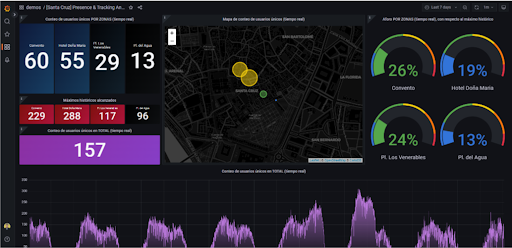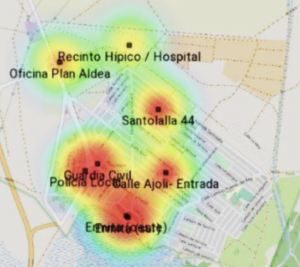Would you like to know how to improve the management of your tourist destination, increase the satisfaction of your visitors and contribute to the sustainable development of your municipality? If the answer is yes, then you’re interested in knowing the benefits that a Wi-Fi positioning system –location analytics- can bring. We explain what it consists of, what metrics it offers you and what reasons there are to implement it.
Tourism has become the main economic engine of many municipalities. A situation that has also led to a general tendency to bet on a tourism model that avoids the qualification of “predatory”, or in other words, that is respectful of local life.
To achieve this, while driving economic development, Wi-Fi positioning systems are a highly valued technology and resource. These provide detailed knowledge of visitor behavior and preferences, thus being able to make informed decisions in this regard.
From here on out, we are going to analyze the main data that solutions such as Galgus’ Wi-Fi Location & Presence Analytics can bring, as well as the main benefits that accompany them.
What Metrics Do Wi-Fi Positioning Systems Offer for Tourism Management?
Below, we will describe the main KPIs that these solutions offer, both in terms of the counting of devices in a specific area and the behavior of the flows of people.
Presence Analytics KPIs
- Potential and actual visits: graph showing devices according to their time spent in the vicinity of access points. In this way, it automatically segments into categories such as passerby, bounce, or visitor.
- Visitors by area: shows the evolution of the visitor count in the different areas, without counting passers-by or bounces.
- Average Visit Duration: Shows the time series of the average visit time. It represents the average time visitors spend in the environment.
- Visitors by total daily visit time: This further segments by time within the “bounce” and “visitors” categories. In this case, four new time segmentations are shown: 5-10 minutes, 10-30 minutes, 30-60 minutes, and more than 60 minutes.
- Visitors by day of the week and hour: This is a matrix that indicates the average number of visitors each day of the week, and at each hour.

Location Analytics KPIs
- Action Map: Map with the estimation of the position of each connected device, with the position updated in near real time. Each AP is shown on that same map.
- Heat Map: A color map on top of the area map photo that shows the areas with the highest and lowest device density. In this way, we can see where the crowds have occurred, where the groups of people have gone, or which are the areas with the least presence at any given time. For both connected and non-connected devices.

What are the key reasons to implement a Wi-Fi positioning system in tourist areas?
Safety and protection of citizens and tourists
One of the most highly rated applications for improving tourism management through a Wi-Fi positioning system is related to citizen security.
Thanks to the counting of devices, it is possible to know practically in real time if an area is saturated and exceeds the maximum capacity established. In such a case, it is possible to send alarms and notifications to utilities to act accordingly.
A really valuable use both for day-to-day use, and especially when holding events and celebrations where large numbers of people gather.
Improve the visitor experience and boost the local economy
Wi-Fi positioning systems make it possible to know in high detail the behavior of tourist flows in areas of interest and, therefore, their preferences.
With this data, managers can design strategies and offer actions tailored to the visitor’s taste. For example, in the event that there is a high number of people at a specific point, tourists could be redirected to others with less saturation.
In addition, on the part of local businesses, having data on the behavior of tourists is an asset of great value in order to offer them an offer adapted to their tastes and, therefore, increase their sales figures.
Wi-Fi Positioning System as a Way to Achieve Sustainable Tourism
The smart tourist destination is inexcusably associated with sustainable tourism. In other words, we are looking for tourism that does not alter or harm the quality of life of citizens, that makes a responsible consumption of local resources, respecting the environment and the culture of the place.
Thanks to Wi-Fi Presence & Location Analytics, tourism sustainability is easier to achieve, avoiding tourist saturation. This technology can contribute to sustainable tourism in several ways, such as:
- Improve transport efficiency by reducing energy costs and carbon emissions.
- Control the flow of visitors and the carrying capacity of destinations, avoiding overcrowding and the deterioration of natural and cultural resources.
- Measure the economic, social and environmental impact of tourism , using indicators to evaluate and improve the performance of tourism activities.
Finally, you should know that in order to get the most out of Presence & Location Analytics technology in the tourism sector, at Galgus we offer a solution with a unique precision in the market, which has even been recognized by Gartner for its disruptive nature.
If you want to know in detail everything it can offer in a real application environment, we encourage you to watch this on-demand webinar about our project in the Sevillian neighborhood of Santa Cruz.









